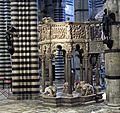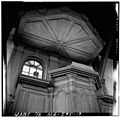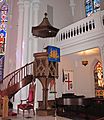Pulpit facts for kids
A pulpit is a small, raised platform, usually found in a church. It comes from the Latin word pulpitum, which means "scaffold" or "platform." From this platform, a member of the clergy (like a priest or pastor) stands to read from the Gospel or give a sermon (a religious talk). In some Protestant churches, the pulpit is seen as the most important piece of furniture in the main worship area, called the sanctuary.
Contents
What is a Pulpit?
A pulpit is like a special stand or stage inside a church. It's built higher than the rest of the floor so that everyone in the congregation can easily see and hear the person speaking. This helps make sure that the important messages shared during a service are clear to everyone.
Why are Pulpits Used?
Pulpits have been used for hundreds of years. Their main purpose is to provide a clear space for someone to lead the service. This includes:
- Reading the Bible: Often, parts of the Bible, especially the Gospel, are read from the pulpit.
- Giving Sermons: The most common use is for delivering a sermon. This is a talk that explains religious teachings or shares a message based on the Bible.
- Leading Prayers: Sometimes, prayers are also led from the pulpit.
Different Kinds of Pulpits
Pulpits come in many different shapes, sizes, and styles. They can be made from various materials like wood, stone, or metal.
- Simple Pulpits: Some pulpits are very simple, just a small stand with a place for a book.
- Elaborate Pulpits: Others are very detailed and decorative, with carvings, statues, or painted designs. These often show the history and art of the time they were built.
- Modern Pulpits: In newer churches, pulpits might have a more modern design, fitting with the building's architecture.
- Outdoor Pulpits: While most pulpits are inside, some churches or religious sites have outdoor pulpits for services held outside.
Images for kids
-
The pulpit of the Notre-Dame de Revel in Revel, Haute-Garonne, France
-
1870 Gothic Revival oak pulpit, Church of St Thomas, Thurstonland
-
19th century wooden pulpit in Canterbury Cathedral
-
The carved wooden pulpit of the Basilica of Saint Clotilde in Paris, France
-
Centrally-placed three-decker pulpit at Gibside Chapel, England, a private chapel on the Calvinist edge of Anglicanism.
-
Siena Cathedral Pulpit, by Nicola Pisano, 1268
-
External gothic pulpit in Saint-Lô, France
-
Outdoor pulpit of Giovanni da Capistrano, Vienna Austria
-
St James's Church, Piccadilly, in the center of London, 1680s
-
Open-air pulpit in the forecourt of the Chapel at Scotch College, Melbourne
-
Fr. Coughlin's outdoor pulpit at the Shrine of the Little Flower in Royal Oak, Michigan.
-
John Wesley's Traveling Pulpit at the World Methodist Museum, Lake Junaluska, NC
-
A modern pulpit in Jakobskirken, Roskilde, Denmark.
-
Ambon of Henry II (1014), Aachen Cathedral
-
Baroque pulpit of 1613 carved in wood by Paolo Froni Parma Cathedral
-
Late Baroque polychromed wood in a South German pilgrimage church
-
Enånger old church in Sweden
-
boat-shaped German Rococo pulpit
-
Terracotta Pieve delle Sante Flora e Lucilla in Santa Fiora, Italy
-
Stone pulpit at Chiesa Bartolomeo in Pantano Pistoia Italy
-
Stone pulpit at Worcester cathedral England
-
A Calvinist 17th century pulpit of the Calvinist Dutch Reformed church in Buren, the Netherlands.
-
Gallus chapel in Greifensee ZH, Switzerland
-
Baroque pulpit in the Amiens Cathedral, France
-
Strasbourg Cathedral, France
-
Neo-Byzantine in the Catholic Westminster Cathedral
-
Pulpit at balcony level, St. Peter Lutheran, Serbin, Texas
-
The Jacobean pulpit of St Helen's, Bishopsgate, which is now located perpendicular to the communion table
See also
 In Spanish: Púlpito para niños
In Spanish: Púlpito para niños















































